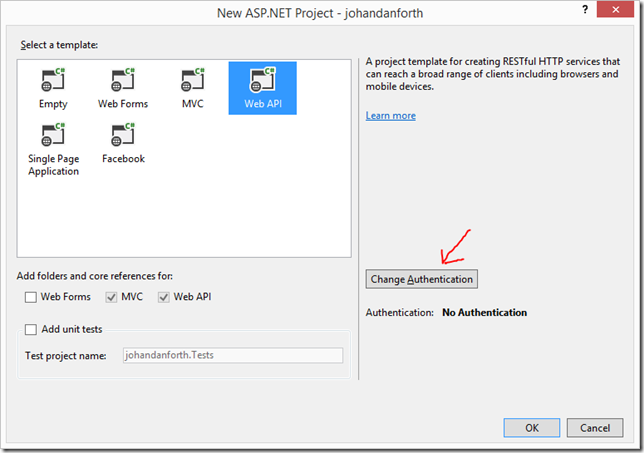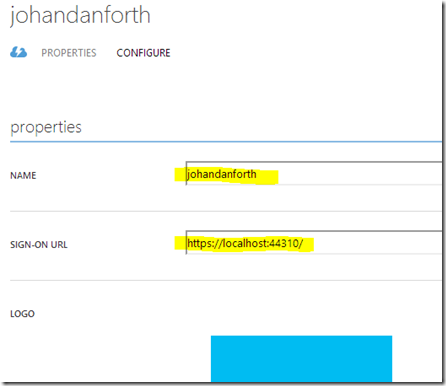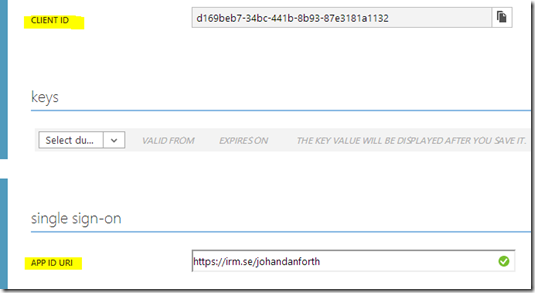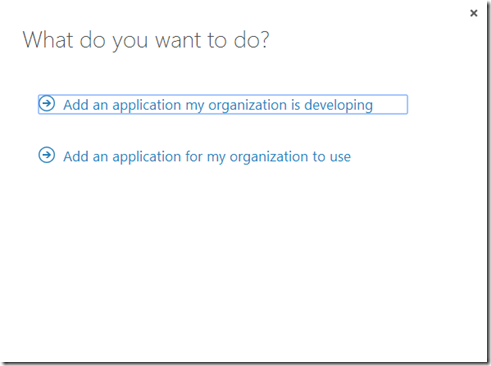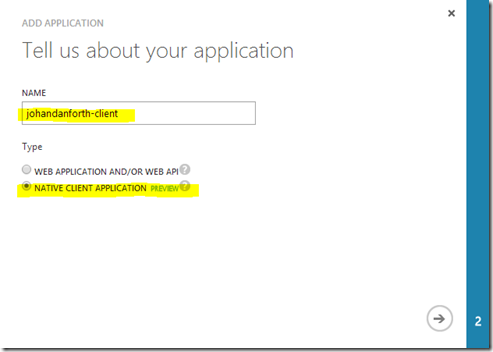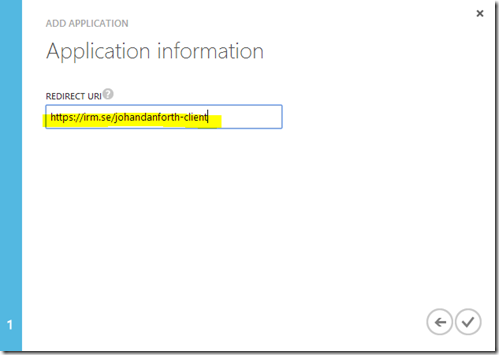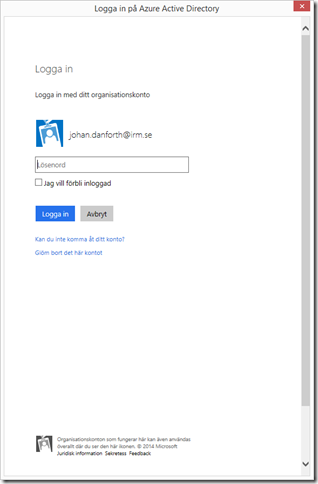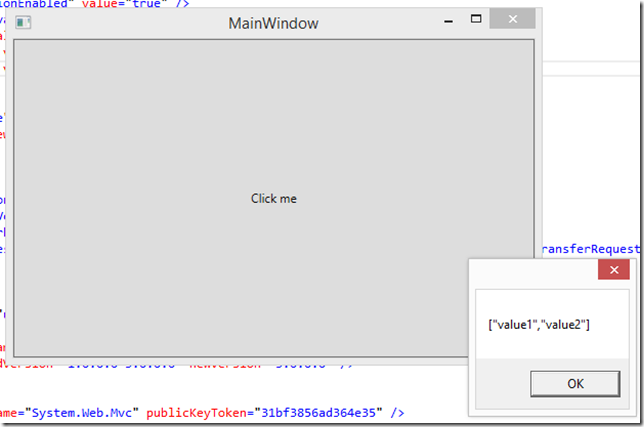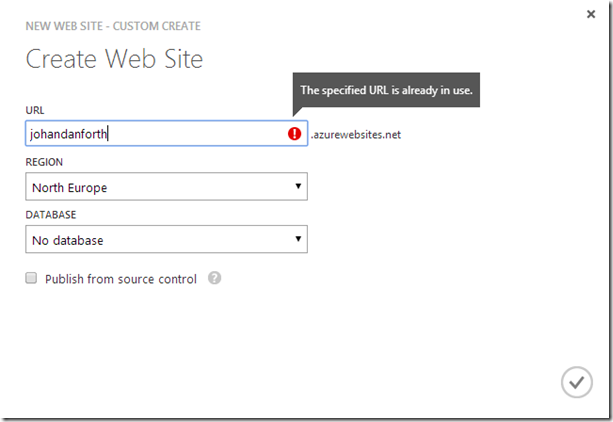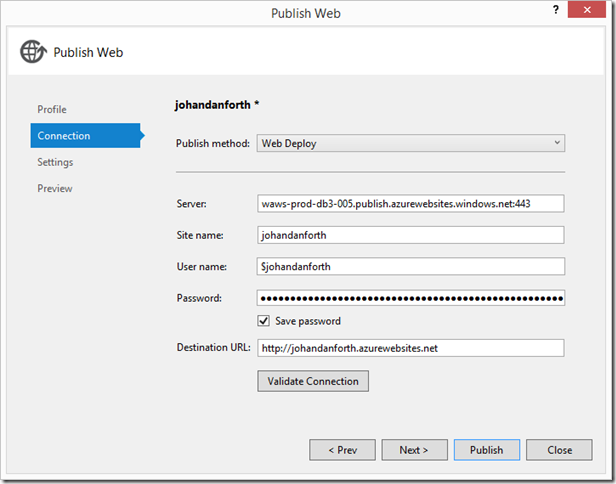Contents tagged with Tutorials
-
Secure ASP.NET Web API with Windows Azure AD
Note that the APIs, tools and methods change quickly in this area, this blog post will get old and die eventually…
Many organizations now look at the Azure environment to host their websites and web APIs, and some decide to move their mail and Active Directory too. Now with the latest updates and previews in Azure, you’re able to secure your web APIs with Azure AD. Vittorio Bertocci wrote an article for MSDN Magazine about Secure ASP.NET Web API with Windows Azure AD and Microsoft OWIN Components and it worked fine up until a couple of weeks ago when things moved around in these parts of Azure

I will try to describe in detail how to secure your web API with Azure Active Directory now, using Visual Studio 2013 and the preview of ADAL (Active Directory Authentication Library) package.
Create a web API project
Fire up Visual Studio and create a new ASP.NET Web Application. I’m calling mine “johandanforth”, I’m selecting “Web API” and click the “Change Authentication”
In the next dialog, click “Organizational Account” and enter the domain of your Azure AD tenant, in my case it’s “irm.se”:
After you press “OK” you’ll be asked to login with your Azure AD account, then “OK” again and Visual Studio will create a web application resource in your Azure AD. Now look it up in the Azure Management application. Note that you may have to log out and in again or restart the Azure management web app to see the newly created application.
In my case the application has been named “johandanforth” and is for securing your development project on localhost. The SIGN-ON URL (also called the APP URL in the management application) is https://localhost:44310/ which can be seen both on the applications overview and if you click on the application and go to the CONFIGURE “tab”:
The sign-on url should be the same as where the web API is hosted, in this case the same localhost-settings as you got in the development project web-settings.
Open up web.config of your web API project and have a look at these settings:
<add key="ida:Audience" value="https://irm.se/johandanforth" /> <add key="ida:ClientID" value="d169beb7-34bc-441b-8b93-87e3181a1132" />
The “ida:Audience” in web.config correspond to the value of APP ID URI of the application resource in the management portal and the “ida:ClientID” correspond to the CLIENT ID in the portal.
Update the web application manifest
Before you any application can access this resource, we must update the “manifest”. Still on the CONFIGURE tab for your web API resource, there should be a MANAGE MANIFEST menu option down at the bottom toolbar. Click it and select “Download Manifest”. It’s a json-text-file, and should save it somewhere where you know is, because we will add a section to it and then upload it again using the same menu option:
Open the json-manifest and replace the "appPermissions": [], section with this:
"appPermissions":[
{
"claimValue":"user_impersonation",
"description":"Allow the application full access to the service on behalf of the signed-in user",
"directAccessGrantTypes":[
],
"displayName":"Have full access to the service",
"impersonationAccessGrantTypes":[
{
"impersonated":"User",
"impersonator":"Application"
}
],
"isDisabled":false,
"origin":"Application",
"permissionId":"b69ee3c9-c40d-4f2a-ac80-961cd1534e40",
"resourceScopeType":"Personal",
"userConsentDescription":"Allow the application full access to the service on your behalf",
"userConsentDisplayName":"Have full access to the service"
}
],At the moment, there doesn’t seem to much in way of documentation on this manifest file, but it should work without modifications. I’ll try to write something about this manifest file as soon as I get some more docs on it.Next thing you do is upload the modified manifest file. Note that the portal may give you an error message during upload, but things seems to work anyway! It may look like this:Create a client
Now let’s try and access the sample ValuesController Web API in your development environment using a web browser, Fiddler or similar. In my case it’s https://localhost:44309/api/values and you should get a HTTP/1.1 401 Unauthorized error back. To be able to access the protected resource, you must add a client resource in the AD and configure it to access the web API.
If you are not there already, in the Azure management portal, go to Active Directory, click on your domain name and select the APPLICATIONS tab. Then click the ADD-icon down the center of the bottom toolbar. Then go ahead and select “Add an application my organization is developing”:
Enter a name for your client (I’m going with “johandanforth-client”, and make sure you select NATIVE CLIENT APPLICATION because we’re going to write a simple Windows WPF client to call our web API:
On the second page, type in a redirect url for your client – it can be anything as long as it is a valid url. I’m going with https://irm.se/johandanforth-client.
Your client is now created, but the last step to do is to give permission to our web API. Scroll down to the bottom of the client application CONFIGURE page and look at the “permissions to other applications (preview)” section. In the dropdown marked “select application” you should be able to see and select your web API. You must also select the “Delegated permissions” dropdown and mark the only option available for you. As you can see, the description matches the text in the manifest file:
Remember to SAVE!
Almost there, hang on…
Create a Windows WPF application for testing
Add a new Windows WPF Application to your solution, I’m calling it “johandanforth.client”, and create a button with a click-event or something to hold the code that will authenticate and get values from your API. Bring up NuGet and search for “ADAL”, make sure you have “Include Prerelease” selected:
Install the prerelease package from February 2014 (it will probably be updated soon), then paste this code into the click-event of that button you created earlier:
using System;
using System.Net.Http;
using System.Windows;
using Microsoft.IdentityModel.Clients.ActiveDirectory;
namespace johandanforth.client
{
public partial class MainWindow : Window
{
public MainWindow()
{
InitializeComponent();
}
private async void Button_Click(object sender, RoutedEventArgs e)
{
//this is to accept dev certificates - do not use in production!
System.Net.ServicePointManager.ServerCertificateValidationCallback = ((a, b, c, d) => true);
var ac = new AuthenticationContext("https://login.windows.net/irm.se"); //ad domain = irm.se
var ar1 = ac.AcquireToken("https://irm.se/johandanforth", //app id uri of the web api
"91b4bc31-92c2-4699-86f5-fa84a718da30", //the client id
new Uri("https://irm.se/johandanforth-client")); //the client redirect uri
var authHeader = ar1.CreateAuthorizationHeader();
var client = new HttpClient();
var request = new HttpRequestMessage(HttpMethod.Get, "https://localhost:44310/api/values");
request.Headers.TryAddWithoutValidation("Authorization", authHeader);
var response = await client.SendAsync(request);
var responseString = await response.Content.ReadAsStringAsync();
MessageBox.Show(responseString);
}
}
}There are a few lines that must be change to work with your sample code. First change the AuthenticaitonContext to match your Azure AD domain/tenant name:
var ac = new AuthenticationContext("https://login.windows.net/irm.se");Next look at the code part which acquires a token – this is when the login dialog pops up and asks the user to log in using his or hers organizational account. This line corresponds to the web API uri, which is the same as the “ida:Audience” in your web.config file, so update it to match that value:
var ar1 = ac.AcquireToken("https://irm.se/johandanforth",
The next line is the client id of the application client you created in Azure AD, look it up and change the id accordingly:
"91b4bc31-92c2-4699-86f5-fa84a718da30",
The last line is the redirect-uri of the client, look it up on the same page in the Azure management portal:
new Uri("https://irm.se/johandanforth-client"));
You must also modify the line with the call to the web API method to match your web server localhost settings:
var request = new HttpRequestMessage(HttpMethod.Get, "https://localhost:44310/api/values");
Now, start the web API program in debug mode and wait until you see the Home Page, then right click and start debug of the WPF client. Click the button and you should be prompted to log in with your organizational account (this is the look of it in Swedish):
After a successful login, the code continues and you should be greeted with this:
Still with me?
Deploy to Azure
This is all well and good (hopefully), but we want to deploy our web API to Azure and run our clients against it in the cloud. To do that we need to:
1) Create a web site to host our web API in Azure
2) Publish our code to the site
3) Create an Azure AD resource for the web API (VS does this for you)
4) Modify the manifest for the web API (like before)
5) Give the client permission to the new resource (like before)
6) Update web.config and the client code to match the IDs and URIs of the new resources (ida:Audience == APP ID URI == the resource you want to access)
7) Publish the code again (to get the updated web.config uploaded)
8) Run!
Here’s some quick shots of some of the steps. First create a web site in Azure by selecting “WEB SITES” in the left hand menu of the Azure Portal, press the big plus-sign down in the corner and create a custom web site. I’m calling mine “johandanforth” (ignore the error message
 )
)Now go back to Visual Studio, right click the web API project and select “Publish…”.
Press the “Import…” button to download and import the publishing profile of the web site you created, and select the newly created Web Site in the dropdown. Click OK.
You have to authenticate one or two times to get past these steps, but should finally get to the last step of the Publish process:
When Visual Studio is done publishing, a browser page will open up with the Home Page showing:
Visual Studio should now have created a new application resource in the Azure Active Directory, so get back to the portal and have a look at the list of AD applications. A resource named “WebApp-xxxxxxxxx.azurewebsites.net” should be listed there. Note – you may have to sign out and sign in to the portal to show the web api resource. This has happened to me a couple of times!
Click on the resource and look at the details in the CONFIGURE tab.
Copy the name of the “APP ID URI” and past it into the “ida:Audience” value in the web.config file of your web API project in Visual Studio:
<add key="ida:Audience" value="https://irm.se/WebApp-johandanforth.azurewebsites.net" />
The same value must also be updated in the WPF client:
var ar1 = ac.AcquireToken(https://irm.se/WebApp-johandanforth.azurewebsites.net,
You must also (of course) update the call to the web API method to point at the web site in the cloud:
var request = new HttpRequestMessage(HttpMethod.Get, "https://johandanforth.azurewebsites.net/api/values");
We’re not done yet though… now you have to do the same steps you did for the localhost resource earlier - download and update the manifest file for the web API resource and give the client resource permission to use the service.
Finally (yes finally) – publish the web API project again to get the updated web.config file to the cloud site!
Once the code is published, you should be able to run the client successfully.
Please give feedback if you have problems with any step/s of this walkthrough. Other questions, bugs and such is better asked on the Windows Azure Active Directory forum. I’m still learning these things and trying to keep up with the changes

-
Case Switching on CLR Types
As most .NET developers know, you cannot do case/switch on CLR types and one of the reasons for it was explained pretty well years ago by Peter Hallam on the C# team.
But there are many cases where you would like to iterate through a list of objects if mixed types and do specific things depending on it’s type. For fun I started to try out different ways to do it, some are better than others but they all do the same thing, more or less. I’m also exploring method extensions, method chaining and lambdas and some of the samples almost started to become fluent and DLS like.
Note
Oh, I’m as far from a C# language expert as anyone can be, so there are other ways of doing this I’m sure. The random code below is just me playing around for a simple way of doing case/switching on types that worked in the code I’m currently working on.
Also, if you would like a derived class to do something special, you normally override a method, send in some parameters and let that code whatever it so special. That’s basic OOD, see the Eat() method in the sample code below. But there are cases where you for one reason or other would not like to do this. Enough of that, this is just for fun.
A List of Pets
I was working with a class hierarchy of pets like this:
namespace TypeCase
{
public abstract class Pet
{
public string Name { get; set; }
public abstract void Eat();
public override string ToString()
{
return Name;
}
public Pet Case<T>(Action<T> action) where T : Pet
{
if (this is T)
action.Invoke((T)this);
return this;
}
}
public class Dog : Pet
{
public override void Eat()
{
Console.WriteLine(Name + " eats cats.");
}
}
public class Cat : Pet
{
public override void Eat()
{
Console.WriteLine(Name + " eats mice.");
}
}
}
We got a Cat and a Dog which are both different types of Pet. They have a Name and they can Eat() which is good enough for testing.
Creating the List
I’m creating a simple typed List like this:
var pets = new List<Pet>
{
new Cat { Name = "Morris"},
new Dog { Name = "Buster"}
};
Now we have something to play with. First do something you often see, especially in .NET 1.x code.
Case Switching on Strings
It’s perfectly fine to switch on strings, so this is quite common:
foreach (var pet in pets)
{
switch (pet.GetType().ToString())
{
case "TypeCase.Cat":
Console.WriteLine("A cat called " + pet);
break;
case "TypeCase.Dog":
Console.WriteLine("A dog called " + pet);
break;
}
}
I’m not too fond of this, because you may rename Cat or Dog in the future, or change namespace of “TypeCase” to something else, and even though renaming stuff with Resharper is powerful, strings are often missed. It would have been nice to:
case typeof(Cat):
But that’s not allowed. The case must be a constant.
If Is
A much safer way is to use if … else if … and instead of using string comparing, check the type with the is statement. It’s also faster to type:
foreach (var pet in pets)
{
if (pet is Cat) Console.WriteLine("A cat called " + pet);
else if (pet is Dog) Console.WriteLine("A dog called " + pet);
}
This code is perfectly fine and I’ve used it many times. But what if I wanted to have a Case-like syntax?
Method Extension on Type
I’m thinking of a syntax like this one:
pet.GetType().
Case(typeof(Cat), () => Console.WriteLine("A cat called " + pet)).
Case(typeof(Dog), () => Console.WriteLine("A dog called " + pet));
In this case we’re extending the Type type with a Case method, like this:
public static class TypeExt
{
public static Type Case(this Type t, Type what, Action action)
{
if (t == what)
action.Invoke();
return t;
}
}
The Action parameter encapsulate the anonymous method we’re sending in, containing the stuff we want to do with the pet in question. In the Case() extension method we’re testing to see if we’re given the right Type and Invoke() the anonymous method if so.
Important Note: Without going into details, just make sure you don’t fall into a case of “Access to modified closure” when doing for(each) loops around anonymous methods. To be safe, you have to create a local pet-variable outside of the method:
foreach (var pet in pets)
{
//some code
var safePet = pet;
pet.GetType().
Case(typeof(Cat), () => Console.WriteLine("A cat called " + safePet)).
Case(typeof(Dog), () => Console.WriteLine("A dog called " + safePet));
//some more code
}
Better Method Extension on Type
But I’m not happy with this syntax. If feels more cumbersome than the if…is…if…else… syntax, and whenever you see the use of typeof() in code like this, generics can do some work for you. So I’m going for a syntax like this:
pet.GetType().
Case<Cat>(obj => Console.WriteLine("A cat called " + pet)).
Case<Dog>(obj => Console.WriteLine("A dog called " + pet));
This requires a new method extension:
public static class TypeExt
{
public static Type Case<T>(this Type t, Action<Type> action)
{
if (t == typeof(T))
action.Invoke(t);
return t;
}
}
Looks better, but you still risk getting into the issues with modified closure above and I would like to work on the “obj” parameter as if it was the Pet objekt itself, not the Type. Let’s make it even better:
Even Better Method Extension on Pet
Now I’m going for a syntax that looks like this:
foreach (var pet in pets)
{
pet.
Case<Cat>(c => Console.WriteLine("A cat called " + c)).
Case<Dog>(d => Console.WriteLine("A dog called " + d));
pet.Eat();
}
As you can see, the syntax is cleaner and I can work with the pet object itself as a parameter handled to anonymous method in the lambda statement.
To do this I have to create a method extension which knows about the Pet class:
public static class PetExt
{
public static Pet Case<T>(this Pet pet, Action<T> action) where T : Pet
{
if (pet is T)
action.Invoke((T)pet);
return pet;
}
}
It’s not a generic Case Switcher on Type, but it feels good to me and is easy to work with. And you don’t have the issue with access to modified closures with this one.
Refined Method Extension on List of Pets
I’m throwing in a final variant here, adding the Case method to the list itself:
pets.
Case((Cat c) =>
{
Console.WriteLine("A cat called " + c);
c.Eat();
}).
Case<Dog>(d =>
{
Console.WriteLine("A dog called " + d);
d.Eat();
});
pets.
Case((Cat c) => Console.WriteLine("A cat called " + c)).
Case<Dog>(d => Console.WriteLine("A dog called " + d));
As you can see, there are two ways syntactically to provide the type and the simple extension method for this variant looks like this:
public static class PetListExt
{
public static List<Pet> Case<T>(this List<Pet> pets, Action<T> action) where T : Pet
{
foreach (var pet in pets)
{
if (pet is T)
action.Invoke((T)pet);
}
return pets;
}
}
That’s it. I’ve seen a number of more complex ways to do roughly the same, but I’m not trying to create the ultimate Switch/Case framework, just playing around with c# to create something simple that may make the code easier to read (and fun to code).
-
Try Ruby in the Browser
There's a pretty awesome online "Ruby in your browser" tutorial that you could try. It has a built in Ruby console and everything is interactive. It's takes 15-30 minutes or so to go through, and it's good. Someone put a whole lot of effort and love into making this one for us Ruby newbies. Go check it out, but use a FireFox browser, because I couldn't make it work properly in IE in Vista.
-
How to Use Msbuild.exe with CruiseControl.NET
I just updated my primer/tutorial/walkthrough on CruiseControl.NET with some information about how to use msbuild.exe instead of devenv.exe in your minimal cc.net configuration. One good reason to go with msbuild is that you don't need to install VS.NET on a dedicated build server, and you can also target unit tests, performance tests, code analysis etc. that you may have added using the Team Edition versions of VS.NET.
Please check it out and comment on it if you please.
-
Quickstart on CruiseControl.NET
I just wrote a page about how to set up CruiseControl.NET to compile and test a VS.NET web app solution in a few minutes. It's over at my Walkthroughs and Tutorials section.
-
How to Hook Up a VS.NET 2005 Solution With CruiseControl.NET in a Few Minutes
This is a short "primer" on how to get your CruiseControl.NET (CC.NET) Continuous Integration (CI) Server up and running with a very small configuration, and it will only take you about 5 minutes or so. I’m pretty new to CC.NET so I thought I would share some of the stuff I learned about it when setting it up. I've used it before, but that was some time ago and now I’m planning on using it for an upcoming project so I had to brush things off and see what had changed lately.
I’m listing some NAnt resources as well here, even though I’m not covering NAnt now (but probably will in a future update). If you want to read about NAnt and CC.NET, Joe Field got a great article on it, and I'm sure there are other CC articles out there.
Updates
Nov 25, 2006 - Added information about how to use msbuild.exe and a small sample configuration.
Why CruiseControl.NET?
So why would you like to use something like CruiseControl.NET? Say you have an ASP.NET Web application solution with a few class library projects and some NUnit tests, you keep track of it using VSS and you want to make the move to CI. Say you want it to check out, compile, test and report every time new code is checked in or by schedule every night (this is up to you and dead simple to change). If this is something you’d like to do, keep reading.
Note that this has nothing to do with the Unit Testing features of (some of the) VS.NET Team System Editions, but CC.NET is so flexible it’s possible to use that feature too, via the <msbuild> <task> for example, but that’s for another time. I've updated this page (at the end) with a sample configuration for compiling using msbuild, but not for running unit tests with it (yet)
If you know the basics and just want to get to the configuration file, jump to the section near the end called “CC.NET Configuration” where you got the XML I came up with. Good luck.
Tools and Products
I'm using these tools and products:
- Visual Studio.NET 2005 + Visual Source Safe
- CruiseControl.NET version 1.1.2527, tool for doing Continuous Integration
- NUnit version 2.3.6293 for .NET 2.0, tool and framework for unit testing your code
- NAnt + NAntContrib version 0.85, tool and framework for performing complex build tasks, similar to msbuild.exe. The Contrib
package contains extra stuff you want to use as a NAnt user (not used in this paper yet, but make sure it’s the same versions if you decide to install them now)
Resources
Some good reasources, where you can download the things I listed above:
- CruiseControl.NET– http://ccnet.thoughtworks.com/
- NUnit – http://www.nunit.org/
- NAnt – http://nant.sourceforge.net/ (not used in this paper yet)
- NAntContrib – http://nantcontrib.sourceforge.net/ (not used in this paper yet)
- Great (longer) tutorial on CC.NET by Joe Field - http://joefield.mysite4now.com/blogs/blog/articles/146.aspx
Ways of Building Your Code
Just a few words about different ways to build/compile your code. There are various ways to do this of course, but a few typical ones:
- Let CC.NET build it by using the devenv.exe program (this requires you to install VS.NET on the build server)
- Let CC.NET hand over the build process to msbuild.exe.
- Let CC.NET hand over the build process to NAnt, which in itself can use devenv.exe or msbuild.exe to build you code.
Using devenv.exe is a simple way of doing it, CC.NET got a <task> for it, you just point at your solution file, and I’m sure it will be enough for most people who just wants to get going. But, it won’t give you the precise control you might want to have.
This paper will cover the first one, using devenv.exe, and the second one using msbuild.exe, but it should be enough to get you started.
Download
This tutorial assumes that you already have VS.NET 2005 installed. So start off by downloading the other products listed above. There’s no need to install NAnt unless you want to use that as your build tool. The simplest configuration of CC.NET handles the build on its own, without even involving msbuild.exe, but I recommend that you look at, learn and consider using NAnt for more complex/complete build tasks. You find the links in the Resource section.
Installing
Installing these things is pretty straight forward and needs no help. A few words though... Most of these products are actually mimicking the beautiful way most Java tools are installed – unzip into a directory of your choice. But I recommend using the .msi installers, especially that of CC.NET as it installs a Windows Service as well and a few useful shortcuts to the CC.NET configuration file and the documentation.
The CC.NET .msi installer also creates a website (CC.NET Dashboard) on your IIS if you got that installed. For some reason it doesn’t create any shortcuts to it from the Start menu. I’ll talk about that later.
Speaking about documentation I have to say that the docs are great in most places. Thing is that the stuff you need to read are spread out in several places and I couldn’t find any decent CC.NET configuration that suited me. That’s why I’m writing this paper...
My Test Solution
So, we need something to test on, so I created this mini web app, which consists of 3 VS.NET projects:
- A web app (I used the Web Application Project template for this)
- A class library for a simple Database Access Layer project
- A class library for a few unit tests (using NUnit)
Make sure you install these things so that the solution file is sitting in a folder “above” these projects, like this:
Solution (JohansTestSystem)
Web Project - Johan.Web
DAL Project - Johan.DAL
Test Project - Johan.Test
This will make everything sort of easier for all tools to handle the code and the projects. Start by creating an empty Solution and add new Projects to it as you go. VS.NET will make sure everything gets created where it should. It doesn’t matter where on your disk you are creating these projects, because we will check them out to and build them in another directory.
Finally – add them to Visual Source Safe (or whatever source control system you are using). CC.NET got support for many source control systems.
CC.NET Configuration
Now, to the reason why you are reading this – let me show you an example of a pretty slim configuration to start with. You find the configuration file (ccnet.config) in the /server/ directory of where you installed CC.NET, or via the Start menu created by the CC.NET installation. My examples does not involve NAnt at all right now and will let CC.NET handle the build by calling the devenv.exe or msbuild.exe.
Devenv.exe Configuration Sample
To understand why this first configuration file looks it does, I'll give you some info about where I have installed things and such:
- VSS is installed in C:\Program Files\Microsoft Visual SourceSafe\
- My VSS database is installed in C:\VSS\
- I got a user called “Johan” in VSS
- The solution file is checked into the VSS-project $/JohansTestSystem.root
- I’m checking out and building the solution in the C:\CI\ directory, which means the solution will be checked out to C:\CI\JohansTestSystem\
- I want CC.NET to look for newly checked in files every 60 seconds
- I want CC.NET to use VS.NET devenv.exe to build my solution
- I got NUnit installed in C:\NUNIT\
- I want NUnit to test the application after the build
This is a small, if not the minimum, example of a configuration file for this job:
<cruisecontrol>
<project name="Johans Test System">
<sourcecontrol type="vss" autoGetSource="true" applyLabel="true">
<executable>C:\Program Files\Microsoft Visual SourceSafe\ss.exe</executable>
<project>$/JohansTestSystem.root</project>
<username>Johan</username>
<password></password>
<ssdir>c:\vss\</ssdir>
<workingDirectory>C:\CI\</workingDirectory>
<cleanCopy>true</cleanCopy>
</sourcecontrol>
<triggers>
<intervalTrigger seconds="60" />
</triggers>
<tasks>
<devenv>
<solutionfile>c:\CI\JohansTestSystem\JohansTestSystem.sln</solutionfile>
<configuration>Debug</configuration>
<buildtype>Build</buildtype>
<executable>C:\Program Files\Microsoft Visual Studio 8\Common7\IDE\devenv.com</executable>
<buildTimeoutSeconds>60</buildTimeoutSeconds>
</devenv>
<nunit path="C:\nunit\bin\nunit-console.exe">
<assemblies>
<assembly>C:\CI\JohansTestSystem\Johan.Test\bin\Debug\Johan.Test.dll</assembly>
</assemblies>
</nunit>
</tasks>
<publishers>
<xmllogger />
</publishers>
</project>
</cruisecontrol>
You may want to consider not labeling the code after a build (applyLabel="false") and use another trigger instead of the <intervalTrigger>.
Msbuild.exe Sample Configuration
Now I'll show you how to change the configuration above to use msbuild.exe instead. One good reason do use this configuration is that VS.NET does not have to be installed on the build server. NOTE! If you're using the new Web Application Project template for a website project, you must copy the file Microsoft.WebApplication.targets to C:\Program Files\msbuild\microsoft\visualstudio\v8.0\webapplications\ directory, or the build will fail! The reasons for this is described in several places on the Net.
The circumstanses described earlier are still valid, except that we're using msbuild.exe instead of devenv.exe. So, change the ccnet.config file to look like this:
<cruisecontrol>
<project name="Johans Test System">
<sourcecontrol type="vss" autoGetSource="true" applyLabel="true">
<executable>C:\Program Files\Microsoft Visual SourceSafe\ss.exe</executable>
<project>$/JohansTestSystem.root</project>
<username>Johan</username>
<password></password>
<ssdir>c:\vss\</ssdir>
<workingDirectory>C:\CI\</workingDirectory>
<cleanCopy>true</cleanCopy>
</sourcecontrol>
<triggers>
<intervalTrigger seconds="60" />
</triggers>
<tasks>
<msbuild>
<executable>C:\WINDOWS\Microsoft.NET\Framework\v2.0.50727\MSBuild.exe</executable>
<workingDirectory>c:\CI\JohansTestSystem</workingDirectory>
<projectFile>JohansTestSystem.sln</projectFile>
<buildArgs>/noconsolelogger /p:Configuration=Debug /v:diag</buildArgs>
<targets>Build</targets>
<timeout>15</timeout>
<logger>ThoughtWorks.CruiseControl.MsBuild.XmlLogger,ThoughtWorks.CruiseControl.MsBuild.dll</logger>
</msbuild>
<nunit path="C:\nunit\bin\nunit-console.exe">
<assemblies>
<assembly>C:\CI\JohansTestSystem\Johan.Test\bin\Debug\Johan.Test.dll</assembly>
</assemblies>
</nunit>
</tasks>
<publishers>
<xmllogger />
</publishers>
</project>
</cruisecontrol>
The changes are in bold. The <msbuild> task and the values should be pretty straight forward and they are well described in the ccnet documentation for msbuild. Msbuild doesn't come with XML output so a few friendly people made an XML logger for it, which you need to download and put in project working directory (for me it's C:/CI/JohansTestSystem/) and also reference in the <msbuild> task section (as you can see above). Read about msbuild and the logger on this page.
Finally, you need to do a few touches to the Dashboard configuration, which is the file called dashboard.config in c:/<ccnet>/webdashboard/ directory. First, add the compile-msbuild.xsl to the <xslFileNames> section, so that you get a somewhat nicer looking style to the msbuild output:
<xslFileNames>
<xslFile>xsl\header.xsl</xslFile>
<xslFile>xsl\modifications.xsl</xslFile>
<xslFile>xsl\compile.xsl</xslFile>
<xslFile>xsl\unittests.xsl</xslFile>
<xslFile>xsl\MsTestSummary.xsl</xslFile>
<xslFile>xsl\compile-msbuild.xsl</xslFile>
<xslFile>xsl\fxcop-summary.xsl</xslFile>
<xslFile>xsl\NCoverSummary.xsl</xslFile>
<xslFile>xsl\SimianSummary.xsl</xslFile>
<xslFile>xsl\fitnesse.xsl</xslFile>
</xslFileNames>
You could remove the other files that you're not using, or just leave them there, it doesn't hurt. Then you would like to add the msbuild output to the dashboard menu. In the same configuration file, add a <xslReportBuildPlugin> section:
<xslReportBuildPlugin description="MSBuild Output" actionName="MSBuildOutputBuildPlugin" xslFileName="xsl\msbuild.xsl" />
Run
Now, start CC.NET by clicking on the CruiseControl.NET shortcut on the desktop or find it via the Start menu, or look for ccnet.exe in the /server/ directory where you installed CC.NET.
Even better might actually to be to open up a command prompt and run it from there, because you may get at few errors or warnings the first time and it’s easer to CTRL-C and look at them from there. Don’t bother starting the CC.NET Windows Service until you got a decent config that works well.
If all is well, CC.NET should do its job and go back to sleep mode again, waiting for the next time to trigger. You should have gotten loads of output in the console window and something like this in the end:
[Johans Test System:INFO] Integration complete: Success - 2006-11-11 18:45:23
If not, go back and look at your config file where some path might be wrong. The errors output from CC.NET isn’t the best...
The CC.NET Web Dashboard
If you want to look at the results from the last build, or force a new build, you can use the CC.NET Dashboard. Note that ccnet.exe must be running.
Open a browser and go to http://<your CI host>/ccnet/ and you should see the dashboard where the right hand side shows the projects described in your configuration file, in this case only one project. Click on your project name and then on the report for the latest build which will show you the files modified since last time (and by whom), and how the test run went.
On the left hand side you can click on a number of links to get detailed reports if you like. The NUnit Details report is a good one, and as you can see, CC.NET got support for a number of other tools; NAnt, FxCop, NCover and so on.
That’s it for now. This page will probably get updated with other sample configs where I use NAnt and other configurations with msbuild. As soon as I get a few minutes to write something...
